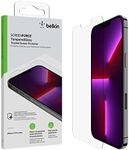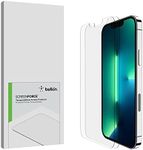Buying Guide for the Best Iphone Screen Protectors
Choosing the right iPhone screen protector can make a big difference in keeping your phone’s display safe from scratches, cracks, and smudges. With so many options available, it’s important to understand the key features that matter most. By focusing on the main specifications, you can find a screen protector that matches your lifestyle and usage habits, ensuring your phone stays protected without sacrificing usability or appearance.MaterialThe material of a screen protector determines its durability, feel, and level of protection. The most common materials are tempered glass and plastic (PET or TPU). Tempered glass protectors are thicker, offer better protection against drops and scratches, and feel more like the original screen, but they can be a bit bulkier. Plastic protectors are thinner and more flexible, making them less noticeable, but they usually provide less impact protection. If you’re prone to dropping your phone or want a glass-like feel, tempered glass is a good choice. If you prefer something slim and mainly want to guard against scratches, a plastic protector might be enough.
Hardness RatingThe hardness rating, often shown as 9H or similar, measures how resistant the screen protector is to scratches. A higher rating means better scratch resistance. Most tempered glass protectors advertise a 9H rating, which is strong enough to resist scratches from keys and coins. If you carry your phone in a pocket or bag with other items, look for a higher hardness rating to keep your screen looking new.
ThicknessThickness affects both the level of protection and the feel of your screen. Thicker protectors (around 0.4mm) offer more impact resistance but may be more noticeable, while thinner ones (around 0.2mm) are less intrusive but might not absorb shocks as well. If you want maximum protection, go for a thicker protector. If you want your phone to feel as close to the original as possible, a thinner option is better.
Clarity and Touch SensitivityClarity refers to how clear the screen looks with the protector on, and touch sensitivity is about how responsive your screen remains. High-quality protectors maintain almost 100% clarity and do not interfere with touch functions. If you use your phone for watching videos or editing photos, or if you’re sensitive to any change in screen feel, prioritize protectors that advertise high clarity and sensitivity.
Oleophobic CoatingAn oleophobic coating helps repel fingerprints, smudges, and oils, making your screen easier to clean. Some protectors have a better coating than others, which can make a big difference if you use your phone a lot or dislike cleaning the screen frequently. If you want your screen to stay clean and smooth, look for a protector with a strong oleophobic layer.
Edge CoverageEdge coverage describes how much of your phone’s front is protected. Some protectors only cover the flat part of the screen, while others are designed to wrap around the curved edges. If you want full protection, especially if your phone has a curved display, look for edge-to-edge or full-coverage protectors. If you use a case that fits tightly around the edges, a standard flat protector might be a better fit to avoid lifting.
Installation MethodThe installation method can affect how easy it is to apply the protector without bubbles or misalignment. Some protectors come with installation kits or frames to help you line things up perfectly. If you’re not confident about applying a screen protector, look for options that include easy-install tools or guides.



















